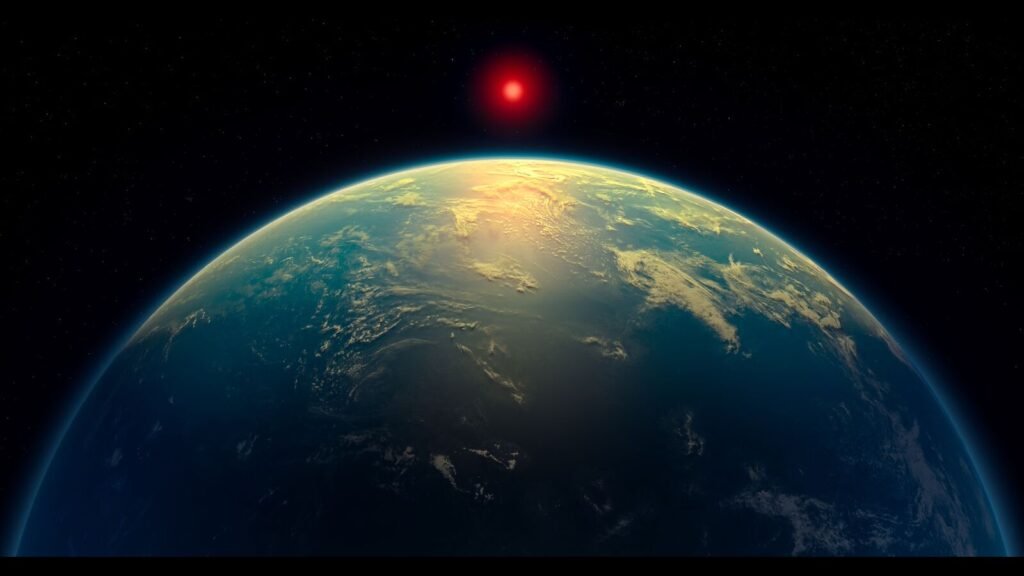
Somak raychaudhury

Imagine observing our sun from 120 light-yars away, using an observatorry as powerful as our james webb space telescope (jwst), trying to figure out with Sun, and white there are signs of life on any of them.
Even with the most powerful of telescopes, the planets are so close to the bright star that they cannot be individually Brightness as it passes in front of the star. DURING TRANSIT, Some of the Starlight Passes Through the Atmosphere of the Planet on the way to the telescope. Different Gases in the Atmosphere Absorb Light at Specific Wavelends, Lending a Unique “Fingerprint” in the transmitted light spectrum. JWST’s Infrared Range Allows It to Proble Wavelends Where Many Important Molecules, Including Water, Methane, Carbon Dioxide, and Various Potential Biosignatures, Exist.
The oxygen and methane in the earth’s atmosphere, which are indicators of biological activity, Albeit Inconclusive, would be too fantle to be detected by an alien jwst from 120 lights from. However, from an orbit near the earth, the jwst has indeed detected posted by biosignatures Light-Years Away.
One Such Planet Atmosphere is K2-18B, A Planet Slightly Smaller Than Neptune (Sub-Neptune, Two-AA-AHALF Times the size of Earth), Around a M-Dewarf Star K2-18, 124 Light-Aerars ( Million trillion km) Away from us – a distance far beyond what any human could Hope to travel in a lifetime. Nevertheles, K2-18B is one of the most-studiied planets among the 6,000 or so planets Around Other stars that have so far been identified throughout the only.
A group from University College London Found Evidence of Water in the Atmosphere of K2-18B as Early as 2019 from Hubble space telescope observations. In 2023, a team of astronomers Led by Nikku Madhusudhan, A Professor at the University of Cambridge, Discovered Meethane and Carbon Dioxide from Hubble Obeservations of this Planette.
Last Week, Madhusudhan and His Group Declared that they have found “signs of life”, based on new jwst observations, on planet k2-18B. This is based on hints of dimethyl sulphide (DMS), a pungent compound, in the atmosphere of k2-18B. Their observations also sugges that the related chemical dimethyl disulphide (DMDS) might also be present. These molecules are interesting for the search of life trust on Earth they are produced by living organisms
These latest results are only “three-sigma”, which means that, assuming normal statistics, there is a 0.3% chance that the detection of the Gases is not correct. This sounds small, but it is not enough to convince the scientific communication. Even if the detection of dimethyl sulphide on k2-18b was to the elevenb was to the entry field’s satisfaction, its presence is not nextrily a bankable Sign of Life. Last Year, The Chemical, Clearly Not of Biological Origin, was observed in the dead, ice spray of a comt 67p/churyumov-gerasimenko. WHATEver Dimethyl Sulfide’s Organic Origins Might Be on Earth, The Universe, In All Its Creativity, is cleared capable of making it without the help of Organisms.
We don’t have much detailed information about k2-18B. We don’t even know for certain what kind of a planet it is. Madhusudhan Pictures a “Hycean” World – Wrapped in Hydrogen, and its surface Hidden Beneath a Global Ocean. Another group, study the same data record, sketches a very different Scene – that of a magma ocean hostel surface, overwhelmingly hot.
To begin with, there are questions about where K2-18B even has water-or a surface that count support life. Modeling Studies of it and similar planets sugges that they are probally barren. Even thought this planet lies in the “habitable zone” of the dwar of star, one must point out that the vicinity of this class of stars is not likely to be very hospitable, due to frequent Flares of HIGHAH-of Near-ultraviolet radiation from the surface of m-dwarf class stars.
Saturn, Jupiter, and Neptune’s atmospheres are made of hydrogen and helium, with traces of methane. These are gaseous planets with no hospital environment. Venus and Mars have Atmospheres of Mostly Carbon Dioxide, and some moons like Titan in our solar system have cupious Amounts of Meethane in their atmosphere. The origin of these gases is not thought to be from biological activity.
The detection of trace gases in the atmospheres of invisible planets a Million trillion km away is indeed superimely different Difential and these are remarkable discoveries. However, Media Headlines Announcing “We-My-Not-Bee-Alone” based on these reviews are unusually hyperbolic.
As carl sagan used to say (repHrasing a quote from laplace), “Extraordinary claims require extraordinary evidence”. I have no doubt that we will one day find life on another planet. My Fear is that by then, we would have cried wolf so ofteen that members of the jaded public might cease to care by then.
Somak raychaudhuri is vice -chancellor and professor of physics, ashoka university. The views expressed are personal




